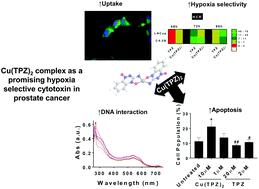当前位置:
X-MOL 学术
›
Biomater. Sci.
›
论文详情
Our official English website, www.x-mol.net, welcomes your
feedback! (Note: you will need to create a separate account there.)
Enhanced selectivity, cellular uptake, and in vitro activity of an intrinsically fluorescent copper-tirapazamine nanocomplex for hypoxia targeted therapy in prostate cancer.
Biomaterials Science ( IF 5.8 ) Pub Date : 2020-04-01 , DOI: 10.1039/c9bm01905g Vera L Silva 1 , Abdessamad Kaassis , Ashkan Dehsorkhi , Cédrik-Roland Koffi , Maja Severic , Moustafa Abdelhamid , Duuamene Nyimanu , Christopher J Morris , Wafa' T Al-Jamal
Biomaterials Science ( IF 5.8 ) Pub Date : 2020-04-01 , DOI: 10.1039/c9bm01905g Vera L Silva 1 , Abdessamad Kaassis , Ashkan Dehsorkhi , Cédrik-Roland Koffi , Maja Severic , Moustafa Abdelhamid , Duuamene Nyimanu , Christopher J Morris , Wafa' T Al-Jamal
Affiliation

|
In the present work, a copper-tirapazamine (TPZ) nanocomplex [Cu(TPZ)2] was synthesized for selective hypoxia-targeted therapy. The nanocomplex revealed a crystalline form, and exhibited higher lipophilicity, compared to TPZ. Furthermore, its stability was confirmed in different media, with minimum dissociation in serum (∼20% up to 72 h). In contrast to other hypoxia-targeted agents, our intrinsically fluorescent nanocomplex offered an invaluable tool to monitor its cellular uptake and intracellular distribution under both normoxia and hypoxia. The conferred higher cellular uptake of the nanocomplex, especially under hypoxia, and its biocompatible reductive potential resulted in superior hypoxia selectivity in two prostate cancer (PC) cell lines. More promisingly, the nanocomplex showed higher potency in three-dimensional tumor spheroids, compared to TPZ, due to its slower metabolism, and probably deeper penetration in tumor spheroids. Interestingly, the nuclear localization of the intact nanocomplex, combined with its higher DNA binding affinity, as evidenced by the DNA binding assay, resulted in significant S-phase cell-cycle arrest, followed by apoptosis in the three-dimensional spheroid model. In conclusion, the presented findings suggested that the Cu(TPZ)2 nanocomplex can be a promising hypoxia-targeted therapeutic, which could potentiate the efficacy of the existing chemo- and radiotherapy in PC.
中文翻译:

固有荧光铜-替拉帕明纳米复合物用于前列腺癌的低氧靶向治疗的增强的选择性,细胞摄取和体外活性。
在本工作中,合成了铜-替拉巴明(TPZ)纳米复合物[Cu(TPZ)2]用于选择性缺氧靶向治疗。与TPZ相比,纳米复合物显示出晶体形式,并表现出更高的亲脂性。此外,它的稳定性在不同的培养基中得到了证实,在血清中的解离最小(至72 h约20%)。与其他缺氧靶向药物相比,我们的固有荧光纳米复合物提供了宝贵的工具,可在常氧和缺氧情况下监测其细胞摄取和细胞内分布。赋予纳米复合物更高的细胞摄取,尤其是在低氧条件下,其生物相容性还原潜力导致在两种前列腺癌(PC)细胞系中具有优越的低氧选择性。更有希望的是,纳米复合物在三维肿瘤球体中显示出更高的功效,与TPZ相比,由于它的新陈代谢较慢,并且可能在肿瘤小球中的渗透更深。有趣的是,完整的纳米复合物的核定位及其较高的DNA结合亲和力,如DNA结合测定所证明,导致了明显的S期细胞周期停滞,随后在三维球体模型中发生了凋亡。总之,提出的发现表明,Cu(TPZ)2纳米复合物可以成为一种有前途的针对缺氧的治疗药物,可以增强PC中现有化学疗法和放射疗法的疗效。导致明显的S期细胞周期停滞,然后在三维球体模型中发生凋亡。总之,提出的发现表明,Cu(TPZ)2纳米复合物可以成为一种有前途的针对缺氧的治疗药物,可以增强PC中现有化学疗法和放射疗法的疗效。导致明显的S期细胞周期停滞,随后在三维球体模型中发生凋亡。总之,提出的发现表明,Cu(TPZ)2纳米复合物可以成为一种有前途的针对缺氧的治疗药物,可以增强PC中现有化学疗法和放射疗法的疗效。
更新日期:2020-03-11
中文翻译:

固有荧光铜-替拉帕明纳米复合物用于前列腺癌的低氧靶向治疗的增强的选择性,细胞摄取和体外活性。
在本工作中,合成了铜-替拉巴明(TPZ)纳米复合物[Cu(TPZ)2]用于选择性缺氧靶向治疗。与TPZ相比,纳米复合物显示出晶体形式,并表现出更高的亲脂性。此外,它的稳定性在不同的培养基中得到了证实,在血清中的解离最小(至72 h约20%)。与其他缺氧靶向药物相比,我们的固有荧光纳米复合物提供了宝贵的工具,可在常氧和缺氧情况下监测其细胞摄取和细胞内分布。赋予纳米复合物更高的细胞摄取,尤其是在低氧条件下,其生物相容性还原潜力导致在两种前列腺癌(PC)细胞系中具有优越的低氧选择性。更有希望的是,纳米复合物在三维肿瘤球体中显示出更高的功效,与TPZ相比,由于它的新陈代谢较慢,并且可能在肿瘤小球中的渗透更深。有趣的是,完整的纳米复合物的核定位及其较高的DNA结合亲和力,如DNA结合测定所证明,导致了明显的S期细胞周期停滞,随后在三维球体模型中发生了凋亡。总之,提出的发现表明,Cu(TPZ)2纳米复合物可以成为一种有前途的针对缺氧的治疗药物,可以增强PC中现有化学疗法和放射疗法的疗效。导致明显的S期细胞周期停滞,然后在三维球体模型中发生凋亡。总之,提出的发现表明,Cu(TPZ)2纳米复合物可以成为一种有前途的针对缺氧的治疗药物,可以增强PC中现有化学疗法和放射疗法的疗效。导致明显的S期细胞周期停滞,随后在三维球体模型中发生凋亡。总之,提出的发现表明,Cu(TPZ)2纳米复合物可以成为一种有前途的针对缺氧的治疗药物,可以增强PC中现有化学疗法和放射疗法的疗效。











































 京公网安备 11010802027423号
京公网安备 11010802027423号